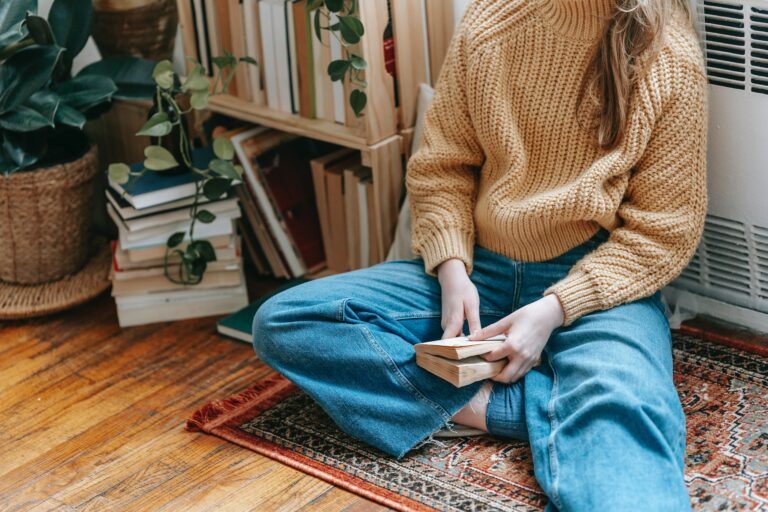It started at breakfast. I would slurp my surgary cereal and read the back of the cereal box all the way down to the number you should call if you found something in the box that shouldn’t be there. When there were no words left to consume on the box, I’d turn to the newest copy of Parents Magazine that my mom had left on the table. I learned all about how to tame a trying toddler and how to install a carseat by the time we needed to leave for school.
When the daily newspaper started coming, I was relieved to now have plenty of material. Street closures. Banks in crisis. A review of the new Johnny Depp movie. It didn’t really matter to me as long as I had something to read. I’d read Dear Abby and the job ads as my parents sat at the table and sorted through the piles of overdue bills. I’d learn about all the new restaurants that I’d never eat in while my mom angrily moved about the kitchen when my dad told her he had to go out of town again.
I loved to read, that was true. But that wasn’t the whole of it. What I really loved – what I really needed – was to avoid stillness.
I knew better than to let my mind sit unoccupied. If I did, I’d start absorbing what felt like chaos around me. For a highly sensitive, anxiously-oriented kid, that felt far too risky. Books and newspapers and cereal boxes felt like shields that kept me safely in another world.
And so I read.
–
I was sixteen years old when I first found myself on a yoga mat. Yoga wasn’t recognized back then by the masses for its mental and physical benefits, and I wasn’t even sure yet what it was I’d agreed to do.
We moved through poses slowly, with what felt like painstaking attention to our breath. Who knew that this thing that my lungs did so automatically warranted so much damn attention? My 60-mile-per-hour self found far too gentle a practice to be called exercise, which meant that I hardly saw the point. In short, I hated it.
But what I most hated was the end, when I was told to lie on my back with my eyes closed and limbs spread out.. When I heard that we’d be in this position for several minutes and that we should focus on quieting our minds, I suddenly understood why the teacher had called it corpse pose. This imposed stillness was going to kill me.
I continued this yoga practice for the next several months, each session ending with the dreaded nothingness of shavasana. I wish I could say that I began relaxing into this quiet experience – that I began to find my path to peace – but I didn’t. I wasn’t ready to be in stillness back then. I didn’t trust I could handle what was in it.
–
I’ve never been alone in how hard I worked to keep my mind occupied. Our aversion to stillness and solitude is, ironically, a very collective experience. Research shows that many people are so opposed to being in their own company, they would rather be in physical pain than sit quietly with themselves.
In a demonstrative study, participants in the UK were asked to spend fifteen minutes by themselves with no distractions. Almost half of them ended up giving themselves voluntary electrical shocks rather than ride out the time alone with themselves. The participants had even felt the shocks prior and rated them as painful, meaning they willfully administered this hurt to themselves.
That study caused a stir in the scientific community, mainly for its methodology, but no one questioned the principal result – people are painfully uncomfortable with stillness.
–
The irony of our discomfort with peace is that it’s the exact thing that so many of us claim to crave. How many times a week do I hear from a friend that they just can’t wait for things to slow down? How many times a day do I silently wish for a few moments of quiet?
I’ll find myself fantasizing about calm evenings at home, and then will agree to a dinner with a friend instead. Sure, I’d love to catch up, but I suspect that actually approaching stillness creates a certain agitation in me. Likewise, I could blame my never-ending to-do list for why relaxation isn’t available to me, but if I’m honest, the to-do list might be a security blanket.
A writer I follow on Instagram once posted something that got under my skin in a way that I’ve since never been able to undo. He said, “Show me the ways you avoid stillness and I’ll show you the patterns that run your life.”
I thought about the years I’d spent caught in hustle and overwork. Avoiding stillness. I thought about my mind’s constant pursuit of the next, more interesting idea. Avoiding stillness. I thought about my embarrassingly high screen time rate last week. Avoiding stillness. I thought about all of the yesses I’d given when I’d wanted to say no, the podcasts I’d listened to instead of being in quiet, the continual pursuit of self-improvement over acceptance. Avoiding stillness.
These were the patterns I was aware of, ones that I’ve been trying to address in various ways and to various degrees throughout my adult life. But had I realized just how connected they were to the fundamental goal of avoiding just being still?
It begs the question, of course, what’s so scary about stillness? What’s hiding there that our whole beings would work in synchrony to avoid it, even at high costs? Why would we let these patterns run our lives?
–
An interesting thing happens to a lot of my clients when I encourage them to be more still. Whether it’s through a more structured practice or just in inviting them into a calmer space, their emotions start to show up. The ones that they’d been working really hard to get out of the way over the course of the week find their way up through their bodies. And once they’re there, there’s no shoving them back again.
In therapy, it’s only then that we get to the juicy stuff, the rawest feelings and the clearest insights. It’s what most of us think we want when we go into therapy, but, again, it’s also what most of us try hard to avoid.
Part of the reason is because in the stillness, the truth can’t hide. The emotions that show up there reveal deep realities, the ones that are messy and inconvenient.
It’s in the stillness that we know this relationship isn’t working. It’s there that we see that we are deeply unsatisfied in our work. It’s there that the bitter beliefs about ourselves get loud and harder to ignore. It’s there that we feel the true weight of all that we are carrying. It’s there that we know that we can’t keep going in the same way.
But just like my third-grade self didn’t know how to manage the feelings swirling around me in the kitchen, we don’t know what to do with all that inconvenience and pain. And so instead we do all the things we possibly can to keep ourselves busy.
–
Years after that first time on the mat, I decided to return to yoga. I was newly living in Chicago and suddenly a yoga studio was around the corner and seemed a great place to meet new people. I’d somehow forgotten how quiet it was and realized quickly that I probably wouldn’t be striking up a lot of conversations here. But I laid out my mat anyway and prayed that I wouldn’t hurt myself.
The teacher walked into the room and took her place in front of us, offering that soft smile that I didn’t totally trust. She welcomed us to yin yoga, where, explained, we would be holding poses for several minutes at a time. This is about deepening, she said. Energy starts to flow in our bodies when we can finally be still.
I was toward the back of the room and considered sneaking out, but I’d already paid for the class and as a broke post-doc, I wasn’t about to let that go to waste. Within twenty minutes, tears were streaming down my face.
If you’ve ever cried in yoga, you know that it wasn’t pain or exhaustion that made me sob. It was finally getting quiet. As I sat on my knees with my torso extended in front of me, noticing my breath move through my body, nothing to distract me, it felt as if every emotion I’d been holding for the past months finally had a place to go.
I was embarrassed by my display of emotion in the class, but I let myself go back, this time armed with tissues. I kept going over the next few months, starting to – incredibly – look forward to the stillness.
It seemed to be a place where I could feel things that felt too tricky to experience in other settings. It felt contained, both within the walls of a studio down the road, and within a 60-minute window. Some days the release that I found within the quiet was downright pleasant. Some days it felt worse than an electric shock.
–
I still find it hard to not do. I’ve far from achieved monk status – or even yogi status for that matter. I find myself reaching by default for a book or my phone whenever a few quiet moments appear before me. I still create elaborate to-do lists and fall into hustle culture. But the difference is – and I do think it’s a vital one – I now often notice what it is I’m doing.
I recognize that the ways that I avoid stillness are the patterns that are running my life, but when I’m aware of those ways and what purpose they are serving, I can be conscious about them. I can decide if these are the particular patterns that I’m okay with. I can ask myself if I might have a guess as to what’s hiding in the stillness today that I’m trying to avoid.
Sometimes it’s truly boredom. Sometimes it’s an awareness of something I can no longer ignore. Sometimes it’s overwhelm. Sometimes it’s deep envy. Sometimes it’s a feeling that I feel guilty for feeling.
When I know that my compulsions are a signal of something waiting to be seen, I can decide whether I’m ready to see it. If I’m not, that’s okay. But I’m not being blindly pulled into the busy.
–
Today, I invite you to gently ask yourself:
What are the ways that you avoid stillness?
If you got still, what might you hear?
If you could know they wouldn’t pull you under, would you be ready to be with those feelings?
What do you need to invite more stillness into your life?


